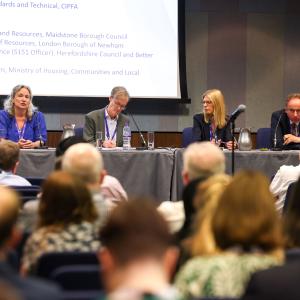
The past few years have not been easy. The enormous disruption of Covid-19 was swiftly followed by the highest inflation seen in the UK for decades. Disrupted supply chains as China bounced in and out of lockdowns were followed by Russia invading Ukraine, which caused oil prices to shoot up and disrupted two of the world’s biggest food exporting economies.
Retail Prices Index inflation peaked in the UK in the 12 months to November 2022, when it reached 14% – the highest annual figure since 1980.
Inflation has many effects, but one of the most significant is that central banks tend to raise interest rates in an attempt to curtail it. Since 1998, the Bank of England has been independently in charge of maintaining price stability (keeping annual inflation to a target – 2.5% at first, which was changed to 2% in 2003), and the weapon it has in its arsenal to achieve this is interest rates.
The idea is simple – inflation is often caused by the economy ‘overheating’, with supply not being able to keep up with demand, so choking demand by making borrowing more expensive will solve the cause of the problem, albeit crudely. But this is not what has happened in the past few years. Demand did rebound from its pandemic slump, but it was supply that caused the problems. Choking demand as central banks have done does not solve the root of the crisis.
Undesirable effects
It creates further problems, too. In the UK, 320,000 people were pushed into poverty by the end of 2023 by the effects of interest rates on housing costs alone, according to the Institute for Fiscal Studies. Choking demand when demand was already low (UK GDP had not recovered to its 2019 level until mid-2021) led, predictably, to a technical recession, with two consecutive quarters of ‘negative growth’.
This has led to the question of whether the Bank of England was right to raise rates so high, and to keep them high for so long. With signs that inflation is set to rise again (albeit to a far lesser degree than in the past few years – still less than 3% in the UK), that question becomes more pressing. If all a central bank has is the hammer of interest rates, does every problem look like the nail of demand-driven inflation? Was hiking up interest rates the right lever to pull in response to this specific recent set of circumstances?
“As far as the Bank of England is concerned, it was the only lever,” says Sir Charlie Bean, professor of Economics at the London School of Economics and a former member of the BoE’s Monetary Policy Committee.
He blamed the government, in part, for the rates going as high as they did (the biggest single jump came after Liz Truss and Kwasi Kwarteng delivered their ill-fated ‘mini-Budget’).
“If fiscal policy had been tighter, then interest rates would not have had to rise quite as much. That’s always the case,” he says.
“The relationship between the government and central bank is really always a leader-follower set-up, so the government is setting its fiscal policy in the knowledge that the central bank will always try to meet its inflation objective.”
Sir Charlie backs the Bank of England’s rate-rising entirely, and would “be in the more hawkish camp” were he still a Monetary Policy Committee member: “The current episode is obviously not a classic case of demand running ahead of supply, and the bank couldn’t do much about the initial inflation spike. Really what they were worried about were second-round effects, and the inflation spike becoming more persistent in its consequences.”
Second-round effects
He is referring to a phenomenon that Bank of England governor Andrew Bailey repeatedly warned about when justifying rate rises: a wage-price spiral. The idea is that sellers pass on higher costs, and workers demand higher wages in response, after which sellers pass on higher costs, and so on.
“The problem with the second-round effects idea is that it depends on the story about labour markets that we have from the 1970s,” says economist James Meadway, a council member of the Progressive Economy Forum.
“We don’t have labour markets that work like that anymore. Most people aren’t in unions, particularly in the private sector.
“When inflation was soaring, wages weren’t. It’s not the world we now live in. Even though wages are still growing, overall during this period they have fallen in real terms.”

Meadway believes that interest rates “were pretty much entirely ineffective”.
“It’s not particularly clear how the Bank of England raising interest rates could counteract the consequences of Russia invading Ukraine and supply issues from China. These things are not plausibly connected.”
Pranesh Narayanan, research fellow at progressive think-tank IPPR, sees some sense in the Bank of England’s response, but says the bank rate has been too high for too long. “Interest rates were the right lever in the sense that once supply shocks happen, inflation is as much a psychological issue as an economic factor, and having a mechanism that reins in that psychological impulse makes sense,” he says. “Interest rates are a signal that there is a ceiling on how high prices are going to go – but are only useful once the situation is out of control.
“However, interest rates being as high as they are now is constraining the economy in a way that isn’t useful. The supply shocks have largely fallen out. Energy prices are still higher than before the crisis, but they have come down. It’s time to start taking a much less restrictive stance.”
How, though, to encourage the Bank of England to take note? If it is true that the hammer of interest rates had made everything look like the nail of demand-led inflation, should we compel the Monetary Policy Committee to look for things other than nails? Some other central banks, notably the US Federal Reserve, give other economic factors the same weight as price stability in their decision-making (in the Fed’s case, its other goal is full employment).
The Bank of England does, of course, take other measures into account, but could the primacy of price stability in the bank’s mandate, which Bailey repeatedly used to justify its decisions, be stopping better policymaking?
“Changing the Bank of England’s mandate is probably quite sensible,” says Narayanan. “A second objective could be as broad as full employment, or it could be closer to the current government’s priorities – perhaps growth or investment. I do think price stability still needs to be there, but it could be supplemented.”
Sir Charlie is sceptical. “The Monetary Policy Committee already takes other things into account. It won’t act really aggressively if it would cause serious harm. I think the lexicographic structure we have [with price stability at the forefront] is right. The committee can point to the primacy of the price stability objective in a way that is helpful in avoiding political pressure to cut interest rates. I think it is unhelpful to add more and more things into the remit, particularly things such as climate change or distribution of income.”

Narrow, clear objectives
Sir Charlie says central banks ought to play a supportive role in the economy, and giving too much responsibility would be a “retrograde move”. “Financial stability [as an objective] makes sense because the bank can use its balance sheet to address that. But adding too much else to an independent agency would take some heat off politicians, who really ought to be the primary actors. If you are going to delegate policy to a support agency, you want a clear objective to which the agency can be held to account for delivering. If you muddy the waters, it risks them taking their eyes off the ball. So, I’m very much in favour of narrow, clear objectives.”
The Reserve Bank of New Zealand is something of an example here. A 2018 law gave it a dual mandate of price stability and maximum sustainable employment (when previously it had been solely price stability). However, in December 2023, the current government returned it to a single mandate after winning power. “Over time, a single focus on price stability is the best way to achieve strong, consistent growth in employment,” said the country’s finance minister Nicola Willis.
Bob Buckle, emeritus professor at Victoria University of Wellington and an external member of the RBNZ Monetary Policy Committee (introducing a committee system was another reform in the 2018 law), says the single mandate framework was effective in achieving and sustaining low inflation until the pandemic era, and that among the concerns with the pre-1989 framework (which saw monetary policy focus on a broader range of objectives) were that “with many objectives and few policy instruments, monetary policy could be poorly targeted, lack accountability and credibility”.
“[UK economist and former Bank of England deputy governor] Paul Tucker and others raised related concerns about the scope of central bank activities and, for example, the interconnection between quantitative easing-type policy instruments [and] fiscal policy during the global financial crisis and the Covid-19 pandemic,” says Buckle. “One concern is a risk that central banks are drawn into a wider net of political decisions, causing problems of accountability and potentially undermining acceptance of central bank operational independence.”
Buckle says it’s “difficult to be sure” of the effect the dual mandate had on decision-making in New Zealand: “Recent research does suggest that the design of the mandate can influence the way committee members make their decisions.” He points to a Bank of International Settlements working paper, which found that supply shocks increase the frequency of dissent among the Federal Reserve’s decision-makers, who have to consider full employment in a way single-mandate banks do not (the same paper found no such effect on the Bank of England, for example). “Their results can be taken to imply that the specification of mandates may influence how MPC members weigh up their decisions, but the significance of differences will depend in part on the nature of the shock or event impacting the economy.”
Serious reform
However, the sentiment that inflation ought to be the domain of central banks is not universally agreed with. Meadway says that if, as he believes, interest rates did nothing to combat recent inflation, the system needs more serious reform. “Central banks historically have one thing they work towards, which is financial stability, and only relatively recently have we given them price stability to work on too. But if the tool we’ve given them [interest rates] doesn’t work for the target we’ve set, it questions the legitimacy of central banks. This is serious, because supply shocks are going to keep happening, thanks to climate change. We need to move away from a world in which central banks are the primary tool to combat inflation.”
Fiscal policy solutions, he says, are the way forward. Price controls, subsidies or other measures that target price gouging are possibilities. The household energy subsidy adopted by the UK, for example, was successful in limiting inflation to an extent. Meadway is even sceptical as to whether monetary policy was all that successful in keeping inflation down in the two decades before the pandemic; instead putting it down largely to cheap manufacturing in east Asia, particularly China.
Supply shocks will only become more common as climate change causes more disasters and insecurity, so the world needs to be sure it is making the right decisions. We need to give central banks the best tools to do the job – or the job most suited to their tools. Whether that involves broadening their mandate is clearly up for debate, but, if it doesn’t, then other areas of policy are going to have to step up instead.



















